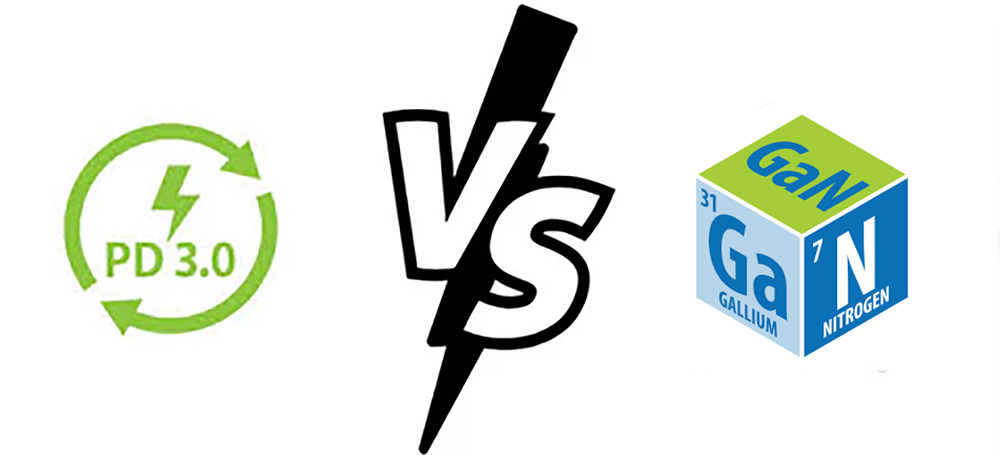GaN Charger vs PD Charger: What Charger Buyers and OEMs Need to Know
In 2025, fast-charging standards continue to evolve quickly, and terms like GaN charger and PD charger often appear side by side in product listings, reviews, and OEM catalogs. However, many buyers still misunderstand the relationship between the two — some assume GaN = PD, while others think they compete.
For charger brands, OEM buyers, and wholesalers, understanding the difference is crucial for selecting the right solution in today’s highly competitive power-supply market. This upgraded guide explains how GaN and PD work, how they differ, and how you should evaluate charger technology for your business — especially as charging enters the AVS/PPS/PD3.1 era.

A GaN charger (Gallium Nitride charger) is a new generation of fast charger built using GaN power semiconductor technology. Compared with traditional silicon chargers, GaN chargers deliver higher efficiency, lower heat generation, and a much smaller form factor—while still supporting high-power output such as 30W, 45W, 65W, 100W, and even 140W fast charging.
GaN chips allow for:
·Higher power efficiency
·Smaller charger size
·Lower heat output
·Faster charging capabilities
Because of these advantages, GaN chargers have become the preferred choice for smartphone manufacturers, notebook brands, and global OEM/ODM charger buyers. In 2025, the demand for GaN fast chargers, GaN USB-C chargers, and USB charger blocks with GaN inside continues to rise, especially in Europe, Korea, and Middle Eastern markets.
A GaN charger is essentially a more efficient and advanced type of fast charger, capable of supporting major protocols such as:
·USB-C PD / PD3.1
·PPS
·QC3.0 QC4.0
·AVS
·Samsung 45W Super Fast Charging
·Apple 20W/30W/35W/45W/96W/140W PD charging
This makes GaN chargers extremely popular among wholesale charger distributors, charger factories, and device manufacturers looking for compact high-power charging solutions.
What Is a PD Charger?
PD (USB Power Delivery) is a communication protocol defined by USB-IF. It determines how power is delivered, not what the charger is made of.
A PD charger can:
·Deliver up to 240W under USB PD 3.1
·Adjust voltage dynamically (5V/9V/15V/20V/28V)
·Negotiate power based on device requirements
·Charge laptops, tablets, phones, power banks, monitors, etc.
·Support AVS (Adjustable Voltage Supply) on newer PD3.1 devices
PD = smart charging behavior
GaN = hardware efficiency & size advantage
They complement each other — not compete.
In short: PD defines how the charger communicates with the device, while GaN defines what the charger is made of.

Advantages
✔ Smaller & lighter even for 100W–140W levels
✔ Higher efficiency, less wasted heat
✔ Perfect for multi-port chargers (2C / 2C1A / 3C / 4C)
✔ Ideal for high power (45W–240W) PD chargers
✔ Better thermal management, enabling compact designs
Disadvantages
❌ Slightly Higher Cost: GaN material and production is still more expensive than traditional silicon, affecting B2B price points.
❌ Not All Use PD Protocol: Some GaN chargers use only QC or PPS; brands must verify protocol support (e.g. PD 3.0/3.1) with factories.
❌ Heat Management Still Needed: While cooler than silicon, GaN chargers still need proper thermal design, especially above 100W.
Tip for OEM buyers: Always request full specs and Temperature test reports when sourcing GaN chargers from factories.
✅ PD Charger: Pros and Cons for OEM & Charger Wholesalers
Advantages
✔ Universal compatibility
✔ Supports latest devices including iPhone 15–17, Samsung S series, MacBook, Xiaomi
✔ Stable supply chain — easier to source and customize
✔ Supports 20W–240W across all device categories
Disadvantages
❌ PD-only chargers using silicon can be bulky
❌ Some devices still rely on proprietary fast-charging (e.g., OPPO VOOC, vivo, Huawei SCP)
❌ PD alone cannot reduce heat or size — requires GaN for optimization
GaN Charger vs PD Charger: Do They Compete? (What Buyes Often Misunderstand)
Many consumers search for “GaN charger vs PD charger,” but these two concepts are not direct competitors (GaN and PD work together.):
·GaN = material (hardware technology)
·PD = charging protocol (software standard)
A GaN PD charger simply means a PD fast charger built with GaN components.
This is why most modern fast chargers—from 20W phone chargers to 140W laptop chargers—are actually GaN PD chargers. Many modern chargers combine GaN compone.
| Feature | Gan Charger | PD Charger |
| Deffinition | Material/Technology | Protocol/Charging Standard |
| Focus | Improve efficiency + reduce size | Smart Charging, Compatibility |
| Common Wattages | 30W to 240W | 18W to 240W |
| Works Alone? | Yes | Yes |
| Best Use Case | High-power & multi-port chargers | Universal device compatibility |
| Ideal Combo | GaN + PD 3.0/PD 3.1 | GaN recommended |
For OEM buyers, choosing GaN over traditional silicon provides clear advantages:
·Smaller size USB charger block
·Lower temperature rise
·Higher conversion efficiency
·Better compatibility with PD/PPS/AVS/DPS
·Lower long-term cost in high-volume manufacturing

Today’s best chargers — especially for OEM and B2B customers — combine GaN hardware + PD protocol to deliver:
·Faster charging
·Cooler thermal performance
·Compact size
·Global compatibility
·Multi-port efficiency
This is why the majority of 65W / 100W / 140W chargers in Europe use GaN + PD + PPS.
✅ Explore this related blog: What Are Standard Charger and Non-standard Charger?
Brands & OEM : What to Look For
If you're sourcing from a charger factory or supplier, ensure the product clearly states:
·"GaN + PD charger" — not just one or the other
·Power rating (in watts) — e.g. 65W, 100W, 140W
·Protocol support — PD 3.0 / 3.1, PPS, QC
·Certification — CE, RoHS, ERP, KC, ETL, FCC, EAC, GS, safety chips
🔍 Tip: If your customers are using MacBook, Galaxy, iPhone 15, or Steam Deck, GaN + PD 100W chargers are ideal.

GaN Chargers (Non-PD)
·Certain proprietary charging ecosystems
·Ultra-small travel chargers
·May use QC or PPS protocols instead
PD Chargers (Non-GaN)
·Cost-sensitive markets
·Larger adapters for office/home use
·Slower charging due to heat/efficiency limits
GaN + PD Chargers (Recommended for OEMs)
·High-demand markets in Europe, Middle East, Korea
·Multi-port chargers for laptops + phones
·High-wattage charging with universal compatibility
·Premium segments
·USB charger block products for retail stores
Conclusion
The decision is not “GaN vs PD” — the best chargers use both. GaN brings power efficiency and compact size, while PD provides universal compatibility and power negotiation.
For OEM brands, wholesalers, and charger factories, GaN + PD is now the industry standard, especially in 20W–140W fast charging.
🔌 Why are gallium nitride (GaN) USB chargers dominating the market?
The term USB charger block has become increasingly popular across US and EU search trends.
In 2025, most buyers who search for “USB charger block” are actually looking for a compact GaN charger with:
·USB-C fast charging
·PD/PPS protocol support
·Multi-port output options (1C / 2C / 1C1A / 2C1A)
·High power in a pocket-size form factor
A GaN USB charger block offers all these benefits, making it the strongest solution for smartphone brands, laptop makers, and global distributors looking for:
·Lightweight travel chargers
·High-wattage adapters
·OEM/ODM customizable chargers
·Eco-friendly small-size power design
Across retail & wholesale markets, GaN chargers now account for over 70% of new USB charger blocks sold by European distributors (industry estimation).
🏭 For Factories, OEMs, and Wholesalers
If you're sourcing from a charger factory or designing an OEM product, here’s what we recommend:
🔹 Want the best performance and design? Choose PD + GaN 65W / 100W / 140W chargers.
🔹 For cost-sensitive markets, PD chargers with silicon can still meet entry-level demand.
🔹 For desktop multi-port chargers, prioritize GaN for reduced heat and form factor.
🔗 Related Zonsan Blog Posts
USB-C vs. USB-A vs. USB-B: Which Connector Is Best for Your Devices?
Super Fast Charging vs. Fast Charging.